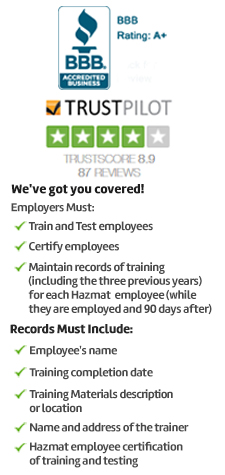
IATA DGR Class 2 Training

This online training and certification course has been made with an intention of educating candidates about how to apply IATA Dangerous Goods Regulations in their workplace, transporters and handlers responsibilities and procedures to recognize, register, mark, label, carry, pack, safe handle and ship consignments of dangerous goods.
The course syllabus also includes module for Class 2 gases which provides systematic procedures to identify, safe handling and shipment of dangerous gases.
Governing regulations
Shipping of hazardous gases by air carriers is strictly follows the guidelines of IATA Class 2 Dangerous Goods Regulations.
This online certification course fulfils the training requirements of all kinds of air carriers, including FedEx and UPS.
Course Overview
The online course educates students about the methods to apply and use IATA Dangerous Goods Regulations while shipping dangerous gases, duties of transporters, best way to recognize, register, mark, pack, label, carry, and ship different category of dangerous items. Students also provided with statistical analysis and important case studies to make them understand the importance of safe handling of dangerous goods at air transports and regulations involved.
Who Must Take this Course?
IATA DGR regulations envisage that training should be given and verified to workers who are marked in Table 1.5.A (Airline verifying and registering staff, transporters, packers and freight carriers, Cargo training and development experts; load control and ground handling workers; regulatory enforcement specialists; station and operations specialists; and security managers).
Course Format
Our IATA Dangerous Goods Regulations Shipping Class 2 training and certification course is packed with quality content, graphics, audio presentations, practice questions and a final exam.
Upon successful completion each student will receive Hard copy of completion certificate and can print a wallet card
Mode e-learning
After the successful completion of the course, every student will get a hard copy of completion certificate and printout of a wallet card.
Continuing education credits?
Each student will receive 0.3 CEUs (or 3 CMEs) for completing this transport safety course.
Topics Covered
- About This Course
- Course Objectives
- Introduction to Dangerous Goods Regulations
- Philosophy of Dangerous Goods Regulations
- Key Terms and Concepts
- Dangerous Goods Incidents and Statistics
- How to Use the DGR
- Changes to the 59th Edition
- Introduction to Dangerous Goods Regulations
- Philosophy of Dangerous Goods Regulations
- Key Terms and Concepts
- Dangerous Goods Incidents and Statistics
- How to Use the DGR
- Changes to the 59th Edition
- Limitations
- Forbidden Dangerous Goods
- Hidden Dangerous Goods
- Dangerous Goods Carried by Passengers or Crew
- Dangerous Goods Transported by Post
- Operator’s Property Exceptions
- Excepted Quantities
- Limited Quantities
- Variations
- Classification
- Packing Groups
- Shipper’s Responsibilities
- Multiple Hazards
- Samples
- Identification
- Selecting the Proper Shipping Name
- Using the List of Dangerous Goods
- Packing
- Shipper’s Responsibilities
- Overpacks
- Salvage Packaging
- General Packing Requirements
- Specific Packing Instructions
- Packaging Specifications and Performance Tests
- Codes
- Markings
- Requirements for Inner Packagings
- UN Outer, Single, and Composite Packagings
- General Testing Requirements
- Types of Tests
- Test Reports
- Specific Testing Requirements
- Marking and Labeling
- Markings
- Labels
- General Label Specifications
- Hazard Labels
- Handling Labels
- Documentation
- Shipper’s Declaration
- Completing the Shipper’s Declaration
- Air Waybill
- Additional Documentation
- Handling
- Acceptance
- Loading
- Inspections
- Provisions for Pilot-in-Command
- Informing Passengers and Shippers
- Reporting
- Document Retention
- Class 2 Gases
- Definitions
- Primary Hazards
- Three Divisions
- Exemptions
- Limited and Excepted Quantities
- Mixtures and Hazard Precedence
- Aerosols and Aerosol Dispensers
- Packing Instructions
- Packaging Specifications
- Summary
- Additional Resources

 NEBOSH CERTIFICATE
NEBOSH CERTIFICATE NEBOSH DIPLOMA
NEBOSH DIPLOMA IOSH
IOSH SAFETY DIPLOMA
SAFETY DIPLOMA CPD UK
CPD UK ROSPA UK
ROSPA UK FOOD SAFETY
FOOD SAFETY 



